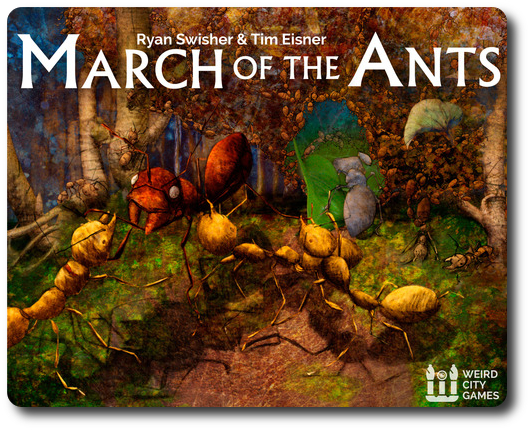
The Basics:
- For ages 8 and up (publisher suggests 13+)
- For 1 to 5 players
- Approximately 60 minutes to complete
Geek Skills:
- Counting & Math
- Logical & Critical Decision Making
- Reading
- Pattern/Color Matching
- Strategy & Tactics
- Risk vs. Reward
- Cooperative & Team Play
- Hand/Resource Management
- Worker Placement & Area Control
Learning Curve:
- Child – Moderate
- Adult – Easy
Theme & Narrative:
- Protect your nest, explore the land, and kick some enemy ant butt
Endorsements:
- Gamer Geek approved!
- Parent Geek approved!
- Child Geek approved!
Overview
American author, poet, and many other things, Henry David Thoreau, said “It is not enough to be busy. So are the ants. The question is: What are we busy about?” Which is to say, work for the sake of work is meaningless without a goal. In this game, players will put their ants to work and there is much to keep them busy, but victory will go to the player who has a plan.
March of the Ants, designed by Tim Eisner, Ryan Swisher, and published by Weird City Games, is comprised of 1 Great Tunnel tile, 25 tiles (8 Starting, 17 Standard), 66 cards, 5 Nest mats, 180 cubes (36 per player in the colors red, yellow, black, blue, and purple), 5 Player markers, 30 Food tokens, 1 score track, 15 Centipede/Wormhole counters, 1 round marker, and 1 Active Player marker. The component quality is excellent. The tiles, counters, and markers are made of thick cardboard and the mats are made of thick cardstock. The cubes are made of wood.
The Ants Go Marching One by One
To set up the game, first place the Great Tunnel tile in the middle of the playing area. This is the largest tile in the game.
Second, place the score track to one side of the game playing area (or assign 1 player to keep track of every player’s score) and give each player 1 Nest mat to place in front of them. Return any unused Nest mats to the game box.
Third, give each player all 36 cubes of their selected color and 1 Player marker that matches the cube color. The cubes should be placed next to the player’s Nest mat and the Player marker is placed on the starting space on the score track. Return any unused cubes and Player markers to the game box.
Fourth, have each player place 5 cubes on their “Larvae Chamber” Nest mat space and 1 cube on the Great Tunnel tile.
Fifth, place the Centipede, Wormhole, and Food tokens in separate piles off to one side of the game playing area. Give each player 2 Food tokens, which are then placed on the player’s “Food Stores” Nest mat space.
Sixth, shuffle the cards and deal 2 to each player, face-down. Players should look at their cards, but keep them private for now. Place the remaining deck of cards face-down by the tokens.
Seventh, shuffle the “Standard” tiles and place them face-down in a stack next to the cards.
Eighth, shuffle and randomly select 2 “Starting” tiles per player. For example, in a 3 player game, you would select 6 “Starting” tiles. Place the selected “Starting” tile face-down on top of the “Standard” tile stack. Return any unused “Starting” tiles to the game box.
Ninth, place the round marker on the “Early Spring” Great Tunnel space.
That’s it for game set up. Time to get marching! Select the first player, give them the Active Player marker, and begin.
King of the Ant Hill
March of the Ants is played in a set number of rounds with each round comprised of 3 specific phases and any number of player turns. Each round in the game represents a season and each phases represents the actions the player takes during that round to increase their chances of survival. When a player takes their action, the player’s opponents have the option of taking a reaction, keeping everyone in the game even if it isn’t the player’s turn. A game round is summarized here.
Phase 1: Workers
Starting with the player with the Active Player marker and continuing in turn order sequence, each player takes a turn selecting an action. To help keep track of which player gets to decide the action, the Active Player marker is passed after each player selected action is resolved. Each action will cost the player a resource to perform. If they do not have the resource or do not want to perform an action, they can take the Rest action. The round and the phase begins when the Active Player flips the Active Player marker from the “Moon” side to the “Sun” side.
There are no set number of player turns during this phase. Each player will be able to select an action on their turn until 2 players have selected the Rest action. At which time, the phase ends.
Explore
The Explore action will cost the player 1 Food resource to perform. When taken, the player draws 1 tile and places it next to any other tile where the player has an ant. When placed, the new tile must have at least 1 tunnel connected to another tile, allowing accesses to the new tile from the tile the player’s ant is located. After being placed, at least 1 of the player’s ants must move to the newly placed tile, but the player can move more if they like. Where the ant is placed is important, as a tile could have multiple sites. Place the cube on the site that is to be controlled.
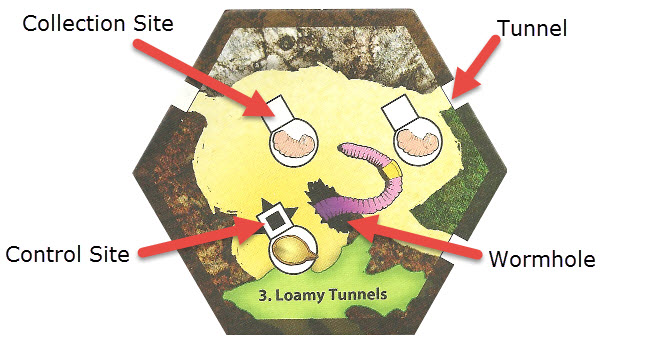
A revealed tile can bring a number of important things into play. Collection sites provide resources, while a control site not only provides resources, but additional bonuses, too. Tunnels connect tiles and allow ants to move to connected adjacent tiles, while wormholes allow players to move to any other tile that also has a wormhole. Everything else in the tile is considered the outskirts, which can be a battleground with other ants and the dreaded Centipedes.
As a reaction, the player’s opponents can now optionally place 1 “larvae” cube from their “Larvae Chamber” Nest mat onto any tile they have an ant cube or in the Great Tunnel.
March
The March action will cost the player 1 Food resource to perform. When taken, the player can take up to 5 move actions starting with any “larvae” cubes in their “Larvae Chamber” Nest mat onto any tile they have an ant cube or in the Great Tunnel. After the “larvae” cubes are moved, the player can move any other “ant” cube to an adjacent tile via tunnels and wormholes. A player is given 1 additional move action for each “Thorax” evolution card for the Worker caste.
As a reaction, the player’s opponents can move 1 “ant” cube (not a “larvae” cube) using 1 move action. Evolution cards do not provide an additional move action.
Forage
For the cost of 1 Food resource, the player draws 2 cards. If the draw deck has been exhausted, shuffle the discard pile to create a new draw deck. These are added to the player’s hand and should not be revealed until played.
As a reaction, the player’s opponent’s may gain 1 “larvae” cube, placing it on their “Larvae Chamber” Nest mat space. The “larvae” cube must come from a cube not currently in use or in play on the player’s Nest mat or the tiles.
Play a Card
Cards will cost the player different resources (larvae or ants) to play. If the player wants to play the card, they must first demonstrate that they can pay for it, showing their opponents and returning the resources to their respective piles. Only 1 card can be played per player’s turn and there are 3 to select from.
The “Event” card provides a one time effect. Thematically speaking, “Event” cards represent action performed by ants that are out of the player’s control or natural occurrences. Once played, it’s immediately resolved and then discarded.
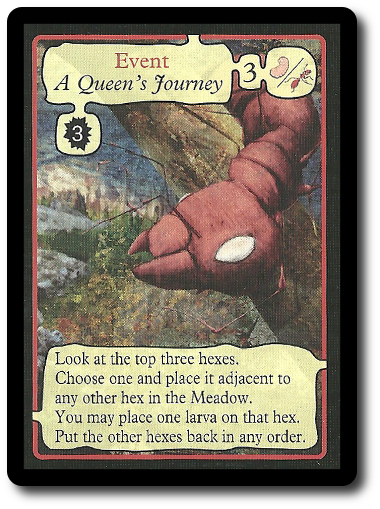
The “Evolution” card is played to the player’s Nest mat to the matching section of the ant’s body (head, thorax, or abdomen). “Evolution” cards are played face-up and permanently improve the player’s ants for the duration of the game. Players can overlay previously played “Evolution” cards, but any bonuses the previous cards provided are no longer available, meaning only the top-most “Evolution” card is used.
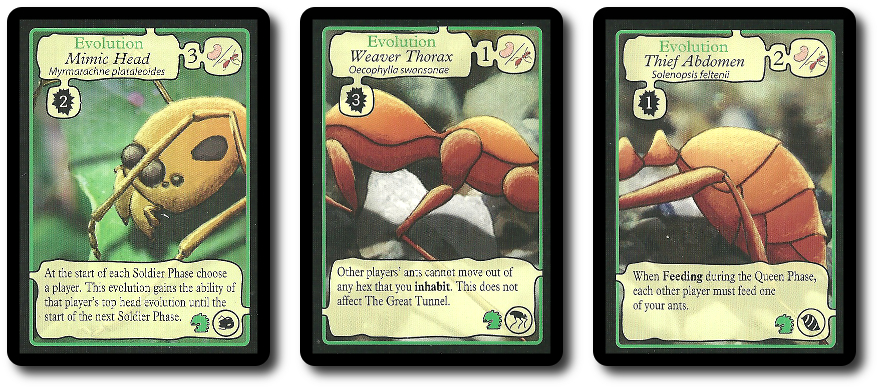
- Caste Bonus: “Evolution” cards provide a caste bonus to the different ant types. Specifically, “Soldier”, “Worker”, and “Queen”.
- Evolved Parts: By evolving parts of the ant, the player gains 3 points for each fully completed evolved ant. This means they have a set of 1 “Head”, 1 “Thorax”, and 1 “Abdomen” in play.
- Combat Efficiency: Evolving ants improves their ability to defend their nest and attack an opponent’s nest.
The “Colony Goal” give the player a minor objective to pursue to obtain points and an advantage. “Colony Goal” cards also provide minor benefits when being pursued to help the player meet their goal. A maximum of 2 “Colony Goal” cards can be in play at a time and remain active for the duration of the game. If the player wants to add a new “Colony Goal” card, they must first discard a “Colony Goal” card already in play if the player already has two.
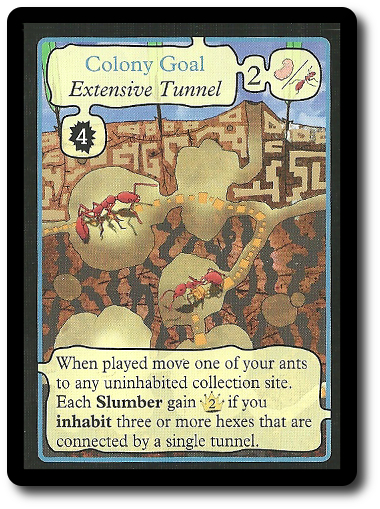
As a reaction, the player’s opponent’s can discard 1 card from their hand to the discard pile and draw 1 new card.
Rest
The Rest action is reserved for those who do not want to take any actions or cannot due to not having enough resources. A player can take the Rest action anytime during the Workers phase except for their first turn.
When selected, the player takes 1 cube not currently in play and places it on their “Resting” track found on the Nest mat. The first resource to be earned is a “larvae” cube. When it’s the player’s turn again, they must take the Rest action. This time a Food token is placed on the second open position on the “Resting” track. This continues until the phase is over, but the player can always react to an opponent’s selected action if they like.
After a second player selects the Rest action and completes it, the phase ends. The player to end the phase keeps the Active Player marker and flips it to the “Moon” side.
Phase 2: Soldiers
Now that the Workers have finished their job, the Soldiers can move in. If the first phase was all about exploration, foraging, and fortification, the second phase is all about combat and defense.
To begin, each player should first resolve any “Evolution” cards that are played on the ant’s head. This should be done in clockwise order starting with the player with the Active Player marker.
Then all players find the lowest numbered tile currently in play and resolve any combat. After combat is resolved, the next highest tile is found and combat is resolved again. This continues until each tile has been inspected and combat has been resolved where required. Ants from different colonies will fight, as will any centipedes. Tiles with ants from different colonies and centipedes are said to be “contested”. The only place combat does not occur is the “Great Tunnel” tile.
Battles will always be between 2 opponents, even if 3 or more different parties are currently in the same contested tile, and only if sites are controlled. The defender is always the player who currently has an “ant” cube on the “Control Site” space. The attacker is the player with the most “ant” cubes on the same tile, but does not currently control the site. This area is referred to as the “Outskirts”. If a “Centipede” token is located on the same tile, it’s always the attacker. All other players who are not the defender or the attacker are not part of combat in the tile.
All battles are completed by following 5 simple steps.
- Determine Army Strength: Count the number of “ant” cubes on the tile, plus the number of “Evolution” cards on their ant’s head. The resulting value is the player’s combat strength.
- Add Ferocity: Starting with the attacker, each player can discard 1 card, face-down. This step is optional for a player. Once both players have either selected a card or passed on playing a card, they are flipped over.
- Determine Outcome: If a card was played, add the Ferocity value to the player’s combat strength. The player with the highest value is the winner. Ties goes to the defending player.
- Report Casualties: The losing combatant must now remove a number of “ant” cubes from the tile equal to the victor’s combat strength. The victor removes a number of “ant” cubes from the tile equal to half of the losing player’s combat strength. If the resulting loose would remove all of the victor’s ants, they leave 1 ant on the tile.
- Collect Spoils: The victor earns 1 Colony point and can freely move their “ant” cubes from the contested tile to any adjacent and empty tile via tunnels.
This ends the battle. Each contested tile is only resolved once per occupying player. This means that if a player still controls the site after the first opponent attempted to take it away, they will enter into another round of combat with another opponent on the same tile.
Centipedes are resolved differently. The Centipede’s combat strength is determined by a random draw of 2 cards, representing the Centipede’s base combat strength and ferocity. Destroying the Centipede awards the victor a Food resource and 1 Colony point. Losing to a Centipede will result in casualties. If a Centipede occupies the same tile as other players, the Centipede will first attack the player who controls the site. After that, it will attach each player in turn. After the Centipede is dealt with, the players attack each other.
Battles continue for each contested tile, with no more battles per tile than there are players occupying it. Once all the tiles are fought over, the phase ends.
Phase 3: The Queen
The Queen of the Nest now makes her move. To begin, players resolve any “Abdomen” evolution cards that provide bonuses beginning with the Active Player and continuing in turn order sequence. Then each player collects resources for each resource site they control (i.e. where an ant is located). Food and Larvae resources are placed on the player’s Nest mat, cards are added to the player’s hand, and Colony points are recorded on the score track.
After harvesting the resources, it’s time to feed the troops. Each Food resource feeds up to 4 ants (unless an evolution bonus is in play). Larvae do not need to be fed and are ignored. All Food resources must be used if it means feeding a player’s ant army. Ants not fed with a Food resource will cannibalize 1 Larvae resource. If ants still remain unfed, the player must remove them. For example, if the player has 1 Food token, 1 larvae, and 6 ants, the Food resource will feed 4 ants and the larvae will feed 1 ant, leaving 1 ant unfeed.
After all ants have been fed (and those who were not removed from the tiles and nests), each player decrees what their Queen will focus on. This will be either food (which gives the player 2 Food tokens) or larvae (which gives the player 5 larvae). These resources are placed on the player’s Nest mat. The Royal Decree (as it’s referred to in the rules) does not take place during the final round of game play.
Finally, each player earns 1 Colony point for each “Inner Meadow” tile they control. Inner Meadow tiles are those directly adjacent to the Great Tunnel tile. Inner Meadow tiles need not be connected to the Great Tunnel via smaller tunnels. Then each player refers to any Colony Goal cards they have in play to determine if they earn additional Colony points.
The round is now over. The round marker is advanced to the next highest number.
King of the Ant Hill
The game continues as described above until the last round and the conclusion of phase 3. Throughout the game, players have been earning Colony points for winning battles, controlling sites on tiles, and from cards that provide evolutionary bonuses. At the end of the final round, the players earn additional points.
- The player with the most larvae earns 3 Colony points.
- The player with the most food earns 3 Colony points.
- The player with the most unplayed cards earns 3 Colony points.
After adjusting the score track, the player with the most Colony points wins the game.
Game Variants
The base game already contains a great deal to do, but if players want to change the game play or try something different, March of the Ants comes with a good number of game variants to try. Each are summarized here.
Longer Game
If 4 rounds of game play isn’t enough, place the round marker on the “0” space on the round track. This buys the players 1 more round of game play, which might not seem like much, but all it takes is one bad or good round of game play to decide who wins or loses.
Beyond the Meadow
There are several tiles included in the game that can be removed when first learning how to play. If they remain in play, a number of them are randomly included in the game set up. When they come into play, the tile describes an effect that must be resolved before the game continues. The use of these tiles does not make the game more complicated, but it does introduce random events that some of the more strategic and tactical players might find too disruptive. Or perfect, depending on the player.
A Tale of Two Ant Hills
March of the Ants can easily be played with only 2 players, but there are a few rule changes to maintain balance. Game set up is slightly changed and the first player to take the Rest action triggers the end of the phase, giving the other player only 1 more turn. The Inner Meadow tiles can give both player’s points, as well.
A Colossal Colony
Playing March of the Ants with up to 5 players is also easily done, but like playing with only 2 players, a 5-player game requires a few changes to the game play and game set up. To begin, pretty much every tile is in use, the reactions to player action are only available to the opponents left and right of the player taking their turn (this reduces game time and adds an additional level of strategy), and the first phase of the game does not end until the third Rest action is taken.
Going Primitive
The Nest mats are double-sided. One side shows the well-known Meadow ant that is used for most games. The other side contains the primitive version of the Meadow ant, which introduces more complicated game play. Mostly because the primitive ants are not as efficient as their more evolved cousins. In essence, playing the primitive version of the Meadow ant introduces a handicap, clipping the speed in which a player would normally evolve, explore, and expand. But it isn’t all bad news. The primitive Meadow ants have a number of advantages to offset their disadvantages by having access to special actions.
- Play event cards for free, but such an action forces ant movement and eliminating any chances of taking the Rest action.
- Explore 2 tiles instead of 1, but the player’s Queen is unable to produce a large number of larvae.
- Mutate by playing 2 evolution cards at once, but doing so will force the player to lose cards in the future and reduce their Colony points.
- Raid nearby tiles with a larger and swifter force of ants, but the player starts with fewer cards in their hand during game set up.
An Army of One or One Million
March of the Ants can be played solo or cooperatively, pitting the player or players against centipede raiders. The game play is similar to a base game, but with a reduction of game components and a few more rules that cover how the centipedes move and attack. Centipedes will invade, rampage, and do all they can to destroy the player’s nest. While playing, the Centipedes earn the equivalent to Colony points. The difficulty of the game can be adjusted by including more or fewer resources the player starts with. At the end of the game, the Centipedes win if they have the most Colony points.
To learn more about March of the Ants, visit the game’s web page.
Final Word
The Child Geeks were torn about this game right from the start. They had difficulty understanding the long-term effect of their actions and very few rounds of game play to correct any mistakes they might have made. This caused a great deal of frustration for some and forced the Child Geeks to play more games than they originally wanted to. Luckily for the Child Geeks, a single game does not take long, but playing multiple games is necessary if you are to get a good feel of how the game plays out. This is especially true for the cards, which are always random and a good draw of cards could mean winning the game or losing. According to one Child Geek, “If you don’t have the right cards, you are at a serious disadvantage, but you can usually make up for it if you try real hard.” Another Child Geek said, “I don’t know how to win this game. I thought I should just explore and then just fight. Each time how I thought I should play the game changed. That is frustrating.” Yes, it can be, but it also speaks to the game’s replayability, since each time you sit down with your ants, the challenges are different. All was not well until we introduced the cooperative game version. Normally I don’t put much weight into a game’s endorsement based on game variants, but in this case, I will be making an exception. When played as a cooperative game, the Child Geeks absolutely loved March of the Ants. They worked together to defend tunnels, hold off the Centipedes, and helped reinforce the nests. For many of the Child Geeks, the game suddenly made sense when playing as a team. In the words of one very happy Child Geek, “The best way to play this game is to team up with other ants.” The Child Geeks voted to approve March of the Ants.

My oldest son attempts to make a deal with a rival nest, while his serious younger brother looks on…
The Parent Geeks enjoyed both the cooperative game with their family and peers and the more combative game. According to one Parent Geek, “This is one of the more interesting 4X games I have played. It has a lot of thematic elements, feels big – even though it’s about small ants – and is challenging. I’m really enjoying it.” The Parent Geek brings up a good point. March of the Ants is a 4X game, wherein the game play focuses on exploring, expanding, exploiting, and exterminating. All on an ant’s scale. The game gave the Parent Geeks a giddy little thrill when they uncovered something new, excited them when combat raged, and satisfied their inner Ant Queen when they were able to manage their resources effectively. As one Parent Geek put it, “The game has taught me a lot about ants. I don’t think I could be one, but I know for a fact I could run a colony.” That might be stretching it, but the message was loud and clear. The Parent Geeks voted to approve March of the Ants.
The Gamer Geeks found the game to be solid, but were disappointed with the game’s overall length of play. According to one Gamer Geek, “Even if you play 5 rounds instead of 4, the game feels too short sometimes. I think that has to do with the fact that sometimes you start the game with a disadvantage.” The disadvantage the Gamer Geek mentioned are the cards. Again, what cards you are initially given can propel a player forward with enough momentum to make it difficult for others to keep up. Not impossible, mind you, but a savvy player with good cards at the start will be very difficult to surpass. Which normally results in the other players attacking the player who is winning. A form of gamers’ karma. That being said, the Gamer Geeks found no faults with the game other than personal preferences not being met. They found March of the Ants to be engaging with deep game play, strategic, tactical, and just about everything else you can imagine a Gamer Geek would like. They especially enjoyed evolving their ants and thought it was a poor move on the designer’s part not to include rocket launchers and lasers for the ants to fire. The Gamer Geeks voted to approve the game.
March of the Ants is too complicated to take out of the box and play with non-gamers, but it’s most certainly possible if you put the time into it. I suggest such games be cooperative, as this introduces all the game play and game components and allows all the players to walk though what they are thinking. It also gives the teacher of the game opportunities to point out possible actions, results of such actions, and discuss any questions. You don’t have that kind of freedom when playing competitively.
I was very pleased with March of the Ants. There is a lot to think about, but not so much as to ever feel totally overwhelmed. Note I said “totally”. What you should and should not do can sometimes blur together, which left a number of our players lost in indecision. The best way to approach the game is to focus first on finding food. Food is the base on which all other strategies are built. Without food, you cannot feed your army. Then it’s all about the larvae. These are soldiers-to-be and will be deployed to fill the ranks of your army. After that, focus on exploration and controlling sites, which goes hand in and with obtaining food.
Evolution of the ants is fun, but should not be the cornerstone of any player’s strategy. Cards are given out randomly and the cards you are provided might not be exactly what you are looking for. You’ll lose the game if you wait for the best cards, so make use of what you have. Colony Goals are important, as they award points and give the player direction when they need it.
Combat is pretty straightforward. I wouldn’t say it’s exciting, but it’s certainly fast. It’s just a numbers game, much like Risk. What does make it interesting is what you are fighting for. Tiles have sites that provides bonuses. I have sent entire armies to capture a single site because of its importance. As such, combat in March of the Ants is not about defeating an opponent, but about maintaining planted flags. You can always make more ants, but you only get to collect on a site so many times.
March of the Ants plays pretty fast, is challenging, requires just enough thinking to play well, and a lot of thinking to play competitively. It also has a great deal of replay value. While not the best 4X game I have ever played, March of the Ants is certainly a great game. After playing it many times, I still don’t feel like I’ve seen it all. I like games like that because they keep you guessing, keep you engaged, and keep you wanting to play them. If you enjoy games where survival of the fittest comes down to how much you are willing to risk, strategy and tactics are necessary to win, and Centipedes keep making a mess of things, then do play March of the Ants. It won’t ruin your picnic.
This game was given to Father Geek as a review copy. Father Geek was not paid, bribed, wined, dined, or threatened in vain hopes of influencing this review. Such is the statuesque and legendary integrity of Father Geek.




Pingback: March of the Ants: Minions of the Meadow Game Expansion Review (prepublished version) - Father Geek